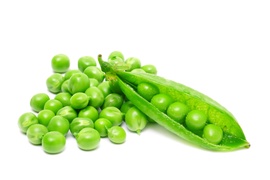
Green peas
Green peas come from garden pea pods that have been harvested just before they are ripe (or they would burst open and release their contents).
Choosing peas
Only the round, green peas inside the pod are eaten. They are naturally wrinkly and minor blemishes do not necessarily mean poor quality.
When buying whole pods there is always a risk that you might get more pod than pea for your money. Go for pods that have a deep and mature green color and that feel full, heavy and as if they are “about to burst”.
Garden peas have a mealier texture and are less sweet than marrow peas – which are the kind you more often find deep frozen and canned. Ask your friendly greengrocer what kind he/she is selling.
Nothing beats the sun-ripened, locally grown peas you buy from May to September, but frozen peas are a great alternative. Chances are – if buying from a reliable brand – that they have been harvested at their peak and frozen immediately, conserving almost all their flavor and goodness.
”Petits pois” is a small and extra delicate French marrow pea.
Storing green peas
Green peas (and their close relatives green beans) are harvested just before they are ripe and should be eaten as soon as possible after harvest.
In the vegetable compartment in the fridge or in a cool, dry cellar they will keep for as long as a week. The longer the peas are left in the pod, the longer they will keep.
Garden peas and marrow peas that are fully matured and dried turn into yellow peas.
Prepare peas
Open and empty the pods just before cooking and serving. Place a humid side towel over the peas and they will keep their color, shape, and texture for longer.
Opening and emptying pea pods is a great job if you have young cooks – say, between four and twelve – in your kitchen.
Cooking green peas
The natural season for green peas is from May to September. This delicious, tender legume only needs a minimum of cooking.
Boil or steam the peas for 3 minutes at the most. Flavor with salt and butter and let this ingredient shine in its own right. The tender textures and sweet flavors go well with white fish, spring chicken, quail, and more.
Frozen peas should also be handled with care. They don’t need to cook for long (and will lose their pretty color if they do) before serving. A little salt and a little fat is all that’s needed to elevate the subtle, summery flavor.
Serve green peas
The pretty green pearls have long been a way of adding some color to a plate, not least when serving old-fashioned and bland food. The more carefully you handle the peas, the more the color and texture is preserved.
Butter and salt crystals make the perfect garnish.
If you aim to add a little color when slow cooking, add the tender peas at the end.
Lightly boiled and mixed peas make a light and delicious puré.
The mild and sweet flavor goes well with "white" proteins like white fish, scallops, veal, chicken, etc.
The classic
Crême Ninon. Green pea soup cooked with first-rate chicken stock. Mix to a smooth, green soup and garnish/serve – traditionally – with a dash of champagne on top.








